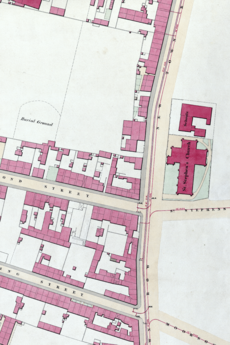St Stephen the Martyr's Church, Newtown Row facts for kids
Quick facts for kids St Stephen the Martyr’s Church, Newtown Row |
|
|---|---|
| 52°29′42.6″N 1°53′43.5″W / 52.495167°N 1.895417°W | |
| Location | Birmingham |
| Country | England |
| Denomination | Church of England |
| History | |
| Dedication | St Stephen |
| Consecrated | 24 July 1844 |
| Architecture | |
| Architect(s) | Richard Cromwell Carpenter |
| Style | Early English Gothic |
| Groundbreaking | 27 September 1842 |
| Completed | 1844 |
| Construction cost | £3,200 |
| Closed | 1950 |
| Specifications | |
| Capacity | 1,150 people |
St Stephen the Martyr's Church was a Church of England church located in Newtown Row, Birmingham. It was an important building in the area for over 100 years.
Building the Church
The church was built with money from the governors of King Edward's School, Birmingham. The Birmingham Church Building Society also helped. The church was designed by a famous architect named Richard Cromwell Carpenter.
Construction started on September 27, 1842. The church was finished in 1844. It was officially opened by the Bishop of Worcester on July 24, 1844. Building the church cost about £3,200, which was a lot of money back then!
Changes Over Time
Over the years, the church and its surrounding area changed. In 1869, a part of St Stephen's church area was used to create a new church area for St Nicolas' Church, Hockley.
In 1890, the vicar (the priest in charge) made some changes to the church services. He introduced new hymns and had the choir wear special robes called surplices. He also changed the direction the priest faced during parts of the service. These changes caused some people to leave and start their own church group nearby.
The church building itself also had updates. In 1896, it went through a big repair project. Then, in 1910, it was rebuilt by an architect named William Bidlake.
The Church Organ
A new organ was installed in the church on September 12, 1847. It was built by a company called Banfield. The organ was an important part of the church's music.
Some of the people who played the organ at St Stephen's included:
- William Akers Edwards (1846 - 1851)
- William C. Stockley (1851 - 1856)
The Church Closes
St Stephen the Martyr's Church closed its doors in 1950. After it closed, the building was taken down.
Some parts of the old church were saved and used in other places. For example, some of the wooden panels were moved to Christ Church, Ward End. The altar, which is a special table used in church services, was taken to St Boniface in Quinton.
Today, the land where St Stephen's Church once stood is used by Royal Mail for their Birmingham Mail Centre.


